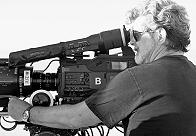| Digital? | ||
| What's that all about? | ||
 |
||
| Review by Ross Anthony | ||
|
No film was used. Not in the camera, not in the projector (at my screening). Since most theaters are not equipped with digital projection, you'll probably see "Clones" transferred to film and projected through a conventional film projector. (Don't worry ... it'll still look good.) A couple of months back, I saw "The Rookie" digitally projected. Though the film was shot on 35mm film, I stuck my neck out and guessed that the production had been shot digitally. This prompted an interesting discussion (click here) with the film's director of photography John Schwartzman ASC (also of "Pearl Harbor" etc.). He was pretty darned sure he'd used film. :) I'd seen digital projection prior and was impressed with its trueness - but I'd only seen it projecting digitally created material. I didn't suspect that it would insert digital artifacts into a production shot on film - hence my error. Worry not, "Clones" is all shot digitally and so digital projection sparks it to life with no apparent straying. I sat close and it looked good! Here's some info from the "Clones" press kit about the topic: In 1996, Rick McCallum (producer) obtained a commitment from Sony to develop a 24 frame high definition progressive scan camera, as well as the key building blocks of 24 frame post production system. Panavision then came aboard to develop a revolutionary new lens that could accommodate digital cinematography. When cameras rolled in June 2000, "Star Wars: Episode II Attack of the Clones" became the first major motion picture created by using the HD 24p digital camera and videotape rather than film. "We received the final version of the camera one week before our first day of principal photography," McCallum recalls, "We started shooting without any film backup whatsoever. We just went for it. We shot in deserts, where temperatures were over 125 degrees for weeks - we shot in torrential rain, and in five different countries throughout the world..." Lucas shot some digital tests on "Phantom," but the technology was not ready for an entire film. The use of digital cameras was a time saver on numerous aspects of production. No longer hampered with the delays of film process, scenes could be immediately modified and edited as soon as Lucas yelled, "Cut!" "Just as we went from silent films to sound pictures, from black and white to color, digital cameras are an addition to the tools we use to create movies," Lucas says. Digital projection will allow the film's images to retain their integrity, not just opening night, but throughout the entire run of the picture. There will be no scratch marks, dust or wear and tear on "Clones" digital prints though their life in the cinema. |
||
|
|
||
Copyright © 2001. Ross Anthony, currently based in Los Angeles, has scripted and shot documentaries, music videos, and shorts in 35 countries across North America, Europe, Africa and Asia. For more reviews visit: RossAnthony.com |
||
|




